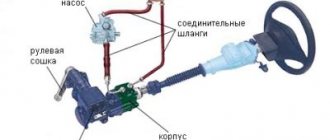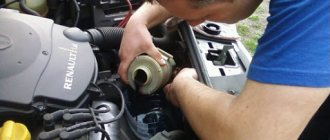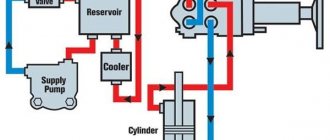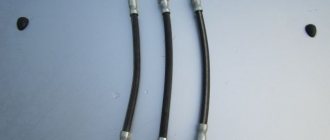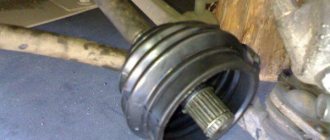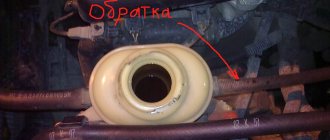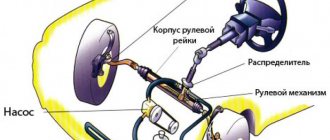How to understand that there is little fluid in the power steering system?
When a power steering leak occurs, fluid loss from the system always follows the same scenario in several stages.
Stage one.
If the power steering reservoir lacks only a little fluid to the normal level, then when the steering wheel is rotated, a sound similar to a howling or itching will begin to be heard from under the hood. But this sound will only be heard when the car is cold. The steering wheel should not become tight. As the car warms up, the sound will subside.
Stage two.
The howling or hum that appears will not subside even when the car warms up, and the steering wheel will become a little wobbly and tight. The sounds will only be heard when the steering wheel is turned.
Stage three.
The howl or hum from under the hood is no longer heard, and the steering wheel has become tight. This means that all the oil has already leaked out of the power steering system. To make sure of this, you need to open the tank lid and look inside.
Attention! Driving, even for a short distance (5 km or more) without any fluid in the power steering system, will most likely result in a damaged power steering pump.
The power steering pump cannot run dry. In most cases, after this it gets damaged - the rotor pair is scuffed, and cannot be repaired. Purchasing a new pump can cost from 10 to 18 or more thousand rubles. It is especially a pity for the power steering pump if it is a dual-circuit pump and is installed on a car with hydraulic suspension. Such a pump can cost from 30 to 100,000 rubles.
In this situation, it is advisable to call a tow truck. Or pour fluid into the power steering reservoir and try to drive under your own power until it leaks out again. If this happens too soon, then a tow truck cannot be avoided.
In the first and second stages of loss of fluid from the power steering , you can still move under your own power. As long as a sound is heard from under the hood when the steering wheel is rotated, and the steering wheel is not completely “petrified,” there is still some amount of oil left in the system, and the pump should not be damaged.
If tow truck assistance is not available.
And the loss of fluid in the system has reached the third stage. At the same time, adding oil does not bring results. Then you need to try to turn off the power steering pump to save it. On many vehicles, the pump is driven by a separate belt. In this case, you need to cut off this belt with a knife. However, before doing this, make sure that other vital units are not driven by the same belt.
The vehicle can be driven with the power steering pump turned off.
But the steering wheel will be tight. You cannot accelerate faster than 45 km/h. You need to try to drive straight and not maneuver too much. You can drive this way no more than 500 km. This is an emergency mode for the steering rack. With further driving it will fail.
If the steering rack leaks heavily, and the power steering pump cannot be turned off by removing the belt.
To save the pump, you can loop its oil line. Those. Place the hose from the pump outlet into the power steering reservoir. The oil will circulate in a circle, bypassing the steering rack. You can drive like this, but this is an emergency mode for the steering rack and you must follow the rules described above.
If any malfunctions of the power steering system occur, you can call the Power Steering Service company and make an appointment for repairs!
8
1200 rub. for the photo report
We pay for photo reports on car repairs. Earnings from 10,000 rubles/month.
Write:
What to do if the power steering hums ? This question is periodically asked by most car owners whose cars have this system installed. What could be the causes and consequences of the breakdown? And is it worth paying attention to this at all?
reasons why the power steering hums . Extraneous sounds indicate an obvious malfunction in the control system. And the sooner you fix it, the more money you will save and will not put yourself at risk of getting into an emergency with a faulty steering system of your car.
Causes of hum
An unpleasant power steering hum can occur under various circumstances. Let's look at the most basic reasons why the power steering hums when turning:
- Low fluid level in the power steering system. You can check this visually by opening the hood and looking at the oil level in the power steering expansion tank. It should be between the MIN and MAX marks. If the level is below the minimum mark, then it is worth adding fluid. However, before doing this, you must definitely find the cause of the leak. Especially if a little time has passed since the last top-up. As a rule, leaks occur at clamps and at joints. Especially if the hoses are already old. Before topping up, be sure to eliminate the cause of the leak .
- The filled liquid does not match the one recommended by the manufacturer. This can cause not only a hum, but also more serious malfunctions. The power steering also due to the fact that, although the fluid meets the specification, it is not intended for operation in special temperature conditions (in significant frosts).
Checking the level and adding fluid to the power steering reservoir Skoda Octavia I Tour 1996 - 2010
Tools:
- Medium flat screwdriver
Parts and consumables:
- Rags
- Funnel (if necessary)
- Power steering fluid VAG Power Steering Fluid G004 (G004000M2)
Notes:
The hydraulic booster of the Skoda Octavia Tour is part of the steering mechanism to make it easier to turn the steering wheel and set the trajectory.
The power steering fluid level should be checked at every maintenance, as well as when a fluid leak is detected from the power steering hydraulic drive, when the steering efficiency decreases or when extraneous noise (howling) appears when the steering wheel is rotated. It is important to determine the location of the leak as accurately as possible, since in this case, the worn or damaged part will most likely need to be replaced.
If you frequently add power steering fluid, it means there are leaks somewhere that should be repaired immediately after detection.
Add special fluid of standard G002 (G004) recommended by the manufacturer to the power steering reservoir.
Check the power steering fluid level with the engine not running.
1. Place the car on a horizontal platform, let the engine cool and open the hood. The power steering reservoir is located on the right side of the engine compartment (next to the coolant reservoir) in the direction of travel of the vehicle.
2. To check the fluid level, first turn the power steering reservoir cap counterclockwise.
3. Remove the cover along with the working fluid level indicator (dipstick).
4. Wipe the pointer (dipstick) with a clean cloth and screw the cap back on.
5. Re-unscrew the cover with the pointer (dipstick). The pointer (probe) is marked MAX (maximum) and MIN (minimum). On a cold engine, the power steering fluid level of the Skoda Octavia Tour should be between these marks.
6. If the level on the gauge (dipstick) is below the MIN mark, add the required amount of working fluid.
Note:
Avoid overfilling the expansion tank with liquid. The liquid level must be kept within acceptable limits and not pour too much into the tank. Since the Skoda Octavia Tour power steering fluid tends to expand during engine operation, an increase in pressure can lead to problems and costly repairs.
7. Close the power steering reservoir cap securely by turning it clockwise.
8. To be secure, tighten the cap with a flat-blade screwdriver. Clean up spilled power steering fluid in Skoda Octavia Tour with a clean rag.
Note:
Make sure you are using the correct power steering fluid for your vehicle, as each power steering fluid requires a different viscosity (density) to properly power the steering system.
The manufacturer does not recommend using gear oil instead of steering fluid. There are many different types of fluid to choose from, and choosing the wrong type can lead to steering failure and seal failure.
Method for checking the cleanliness of power steering fluid
To check the cleanliness of the power steering fluid, simply pour a few drops of fluid from the power steering reservoir onto a clean, light, non-absorbent surface. The liquid must be clean, transparent, no suspended particles should be visible in it, and the color of the liquid must be unambiguous.
There are only three colors of power steering fluid: red, yellow and green. If the color of the fluid only slightly resembles one of those listed, this is a reason to contact a service center to check and, if necessary, replace the power steering fluid.
The article is missing:
- Photos of parts and consumables
- Photo of the instrument
Source: carpedia.club
Power steering hums when cold
Troubleshooting power steering and steering rack
There are several reasons why the power steering hums when cold. The first is that air is leaking through the low pressure lines . To eliminate it, it is enough to put two clamps on the tube going from the reservoir to the power steering pump. In addition, it is worth replacing the ring located on the suction pipe of the pump itself. After installing the clamps, we recommend that you use an oil-resistant sealant to coat the clamps and joints.
You can also conditionally identify another reason, the probability of which is low. Sometimes there are cases when insufficient (poor quality) pumping of the power steering system . In this case, an air bubble remains at the bottom of the tank, which is removed using a syringe. Naturally. that its presence can cause the indicated hum.
Elimination methods may include replacing oil hoses and/or racks, replacing the power steering pump, installing additional clamps on all hoses in order to prevent air leaks into the system. You can also perform the following procedures:
- replacing the O-ring on the expansion tank supply spout;
- installing a new hose from the reservoir to the pump using oil-resistant sealant;
- perform the procedure for expelling air from the system (when performing the procedure, bubbles will appear on the surface of the liquid, which must be given time to burst) by turning the steering wheel with the engine not running;
Another repair option is to replace the O-ring in the power steering pressure suction hose (and, if necessary, the hose itself and both clamps). The fact is that over time it loses elasticity and becomes rigid, that is, it loses elasticity and tightness, and begins to let air through, which enters the system, causing knocking and foam in the tank. The way out is to replace this ring. Sometimes a problem can arise because it can be difficult to find a similar ring in a store. But if you find it, be sure to replace it and place it on the mount and lubricate it with oil-resistant sealant.
For some cars, a special power steering repair kit is available for sale. If problems arise with this unit, the first thing you need to do is buy a repair kit and change the rubber gaskets that are included in it. Moreover, it is advisable to buy original kits (especially important for expensive foreign cars).
Power steering pump bearing
It is also necessary to ensure that there is no dirt in the system fluid . If it is present even in small quantities, over time this will lead to wear on the parts of the power steering pump, which will cause it to begin to make unpleasant sounds and work worse, which will be expressed in increased effort when turning the steering wheel, as well as possible knocking. Therefore, when replacing the fluid, be sure to check for dirt deposits at the bottom of the expansion tank. If they exist, you need to get rid of them. Check the filter in the tank (if there is one). It should be relatively clean and intact, tightly adjacent to the walls of the tank. In some cases, it is better to replace the entire tank and filter rather than try to clean them. Also in this case, it is necessary to remove the rail, disassemble it, wash it from dirt, and also replace the rubber-plastic parts. To do this you need to use the mentioned repair kit.
An unpleasant sound may come from the outer bearing of the power steering pump . Its replacement is easy, without the need to completely disassemble the unit. However, sometimes it can be difficult to find a replacement for him.
There are special additives that are added to power steering fluid. They eliminate the hum of the pump, relieve effort on the steering wheel, increase the clarity of the power steering, reduce the level of vibration of the hydraulic pump, and protect system parts from wear when the oil level is low. However, motorists have different attitudes towards such additives. They really help some, but they only harm others and speed up the time for replacing the power steering pump or replacing it.
When choosing a liquid, pay attention to its temperature characteristics so that it works normally in severe frosts (if necessary). Since oil with high viscosity will create obstacles to the normal operation of the power steering system.
How to change the oil in the power steering?
Replacing power steering fluid is a simple procedure, and you can do it yourself. You will need a syringe with a tube and a container for draining. Unscrew the cap of the power steering reservoir and use a syringe to completely pump out the old fluid, then fill in new fluid to the maximum level. Start the car and turn the steering wheel several times until it stops in each direction. Stop the engine and check the quality of the oil in the reservoir. If the color and degree of transparency are insufficient, repeat the procedure as many times as necessary.
However, keep in mind: if the oil has been used for too long and has lost all its properties, a partial replacement will not be possible - you will have to completely change the fluid.
Power steering hums when hot
If the power steering hums when hot, then there may be several problems. Let's look at several typical situations and methods for solving them.
- If the steering wheel begins to vibrate while the engine is warming up, it is necessary to replace the pump or repair it using a repair kit.
- When a knocking sound appears on a warm engine at low speeds, and disappears at high speeds, this means that the power steering pump has become unusable. In this case, there may be two ways out - replacing the pump and pouring thicker fluid into the power steering system.
- If you pour counterfeit liquid into the system, this may cause it to lose its viscosity , and accordingly, the pump will not be able to create the necessary pressure in the system. The solution is to replace the oil with the original one, after flushing the system (pumping with fresh fluid).
- Steering rack malfunction . When heated, the fluid becomes less viscous and can leak through the seals if they are damaged.
What kind of oil should I put in the power steering?
Before you buy power steering fluid, it is important to determine what is actually being poured into the power steering and which fluid is right for you.
Traditionally, car enthusiasts distinguish oil by color: red, yellow and green. However, the main thing remains not the color, but the composition of the substance, indicating its main characteristics: viscosity, hydraulics, chemical properties, versatility.
Based on the type of base, all oils are divided into mineral and synthetic. In most cases, mineral-based fluids are used for the power steering system, since they do not contain aggressive components that can harm rubber elements and lead to failure. However, there are models for which manufacturers specify synthetics.
If you have to change the power steering oil, follow two main rules:
- do not mix green liquids with substances of other colors;
- do not combine mineral and synthetic preparations.
Power steering buzzes in extreme positions
Do not turn the front wheels for long periods of time
It should be taken into account that when the wheels are turned all the way, the power steering pump operates at maximum load. Therefore, it may make additional sounds that are not a sign of a malfunction. Some automakers report this in their manuals. It is important to distinguish precisely the emergency noises associated with problems in the system.
However, if you are sure that the sounds that appear are the result of a malfunction in the system, then it is necessary to carry out diagnostics. The main reasons that the power steering hums in extreme positions are the same reasons listed above. That is, it is necessary to check the operation of the pump, the fluid level in the expansion tank, the tension of the power steering drive belt, and the cleanliness of the fluid. The situation described below may also occur.
Typically, at the top of the gearbox there is a valve box, which is designed to control hydraulic flows. When the wheel is turned to its extreme position, the flow is blocked by the bypass valve, and the liquid passes through a “small circle,” that is, the pump works on itself and does not cool. This is very harmful for it and is fraught with serious damage - for example, scoring on the cylinder or pump gates. In winter, when the oil is more viscous, this is especially true. Therefore, do not keep the wheels turned all the way for more than 5 seconds .
What to do if the car steering wheel does not rotate well?
Checking the fluid level in the tank
A cylindrical reservoir, clearly marked, is placed near or in the pump, in which the liquid level is checked. The location of the reservoir is almost the same in almost all cars.
The translucent plastic from which the tank can be made allows you to determine the level without special devices, by eye. In a metal or plastic tank, a special dipstick mounted in the lid is used to check the level.
- Sometimes checking the level is not possible without idling the engine;
- The probes or reservoirs are sometimes equipped with notches for a cooled or running engine;
- All other cars have minimum and maximum level marking lines;
- The main thing is to achieve acceptable level values.
Checking the dipstick level
When checking that the level is located, it is necessary to remove it from the tank for the first time, wipe it dry, and then, insert it all the way, remove it.
Checking the color of the liquid
If the liquid has an amber, pink tint, or is transparent, then it is normal. The presence of brown or black liquid indicates contamination. These may be particles of rubber left by connecting hoses, seals, or rings. The car needs to be taken to a mechanic who identifies the parts that need to be replaced at the same time as the fluid.
Sometimes gur fluid appears darker than normal fluid should look. In this case, examine the liquid stain obtained while wiping the dipstick. Matching colors indicate that the fluid does not need to be replaced.
Filling the power steering reservoir with fluid
- If the reservoir has marks, feel free to add fluid to the desired level. When checking the level with a dipstick, add liquid in small doses so as not to overfill the tank;
- Before adding fluid, you need to know for sure that it is intended for use by your car, since in order for the system to be properly fed, a fluid of a certain viscosity (density) is needed;
- It is not recommended to use gear oil as a fluid. There are different types of fluids, and if you choose it incorrectly, the steering may fail and the seals may break;
- You should pour liquid carefully, trying not to overfill the tank - stay within the permissible limit. When the engine is running, the fluid expands, which increases pressure while driving, which can cause problems and lead to costly repairs.
Screwing the reservoir cap
Different brands of cars have different ways of closing the lid. You need to install it or screw it in. Before closing the hood of your car, make sure that the lid fits snugly enough.
This is interesting: What is the difference between camber and toe
Power steering hums after replacement
Sometimes the power steering starts to hum after an oil change. Unpleasant sounds can be caused by the pump if the system has been filled with oil that is less thick than it was before. The fact is that between the inner surface of the stator ring and the rotor plates the output increases. Vibration of the plates also occurs due to the unevenness of the stator surface.
To prevent such a situation, we advise you to use the oil recommended by the manufacturer. This will protect your car from system breakdowns.
It is also possible that a hum may occur after replacing the high-pressure power steering hose. One of the reasons may be a poor-quality hose. Some service stations make the mistake of installing ordinary hydraulic hoses instead of special hoses designed for high pressure and operation in the power steering system. This can cause airing in the system and, accordingly, a hum. The remaining reasons are completely similar to the cases listed above (knock on cold, hot).
Tips for using power steering
In order for the hydraulic booster to work normally and not knock, you must follow a few simple rules:
- Monitor the oil level in the power steering system , top up and change it on time. In addition, check its condition. There is always a risk of purchasing a low-quality liquid, which becomes unusable after a short period of use (check its color and smell).
- Do not hold the wheels in the extreme position (more than 5 seconds) . This is harmful for the power steering pump, which operates without cooling.
- When parking the vehicle, always leave the front wheels level (straight) . This will take the load off the power steering system the next time you start the engine. This advice is especially relevant in cold weather, when the oil thickens.
- If problems occur with the power steering (humming, knocking, increased effort when turning the steering wheel), do not delay repairs . You will not only fix the breakdown at a lower cost, but also protect your car, you and your loved ones from possible emergency situations.
- Constantly monitor the condition of the steering rack . This is especially true for the condition of anthers and seals. This way you will not only extend its service life, but also save money on expensive repairs.
Is there life without power steering?
Hydraulic power steering is responsible not only for comfort, but also increases driving safety. With power steering, the steering wheel turns much easier, and a slight hand movement is enough to turn, which significantly improves the driver’s maneuverability and responsiveness. In addition to convenience, the hydraulic booster smoothes out vibrations and shocks from road unevenness, and also provides additional insurance in the event of force majeure in the event of an unexpected tire puncture, allowing you to hold the steering wheel and level the trajectory.
In addition to all the advantages, power steering has another undeniable advantage - it is simple and unpretentious to maintain. It is enough to periodically check the serviceability of the elements and update the special hydraulic fluid.
Why does my power steering howl?
Let's make it clear right away: in some situations the power steering howls when turning , even if it is working properly. This sound occurs when the wheels are turned all the way to the right or left. With this steering wheel position, the power pump operates at its maximum intensity. Hence the howl or hum. Any car repair begins with diagnostics, so as soon as you notice that the power steering is howling , crunching or humming, you should find out the source of the problem. There can be many reasons for extraneous sounds, and even an experienced technician is not always able to determine what exactly happened offhand. The most common problems that cause the power steering howl :
- the fluid level in the power steering system has decreased;
- oil that is not recommended by the manufacturer has been filled in;
- the quality of the liquid does not meet the standard;
- air has entered the system;
- The power steering pump howls;
- steering rack is faulty;
- The drive belt is loose.
why the power steering howls . Now let's figure out what to do if such a problem occurs with your car.
Which power steering fluid to buy?
When choosing power steering fluid, pay attention to the following characteristics:
- resistance to high temperatures (up to 110ºС);
- the presence of additives that reduce friction and wear;
- the presence of viscosity and acidity stabilizers;
- prevention of foaming;
- anti-corrosion properties;
- safety for the driver (no aggressive chemical components in the composition);
- reliable and recommended manufacturer.
Our choice is KIXX automobile oils from GS Caltex: heat-resistant, environmentally friendly, with universal viscosity characteristics, corrosion inhibitors and antioxidant elements, KIXX oils retain their properties and work effectively in any conditions and temperatures. A wide product range, strict control and the use of the latest technologies have allowed GS Caltex Corporation to be one of the generally recognized world leaders in the production of lubricants for many years.
| Manufacturer | vendor code | Name |
| KIXX | L250944TE1 | Automatic transmission fluid ATF DX-III, synthetic SYNTHETIC (T) KR 4L (old number L522144T) |
In IXORA stores you can always find all the necessary spare parts and accessories. Our qualified managers will help you with your choice!
Low level
It is easy to diagnose this malfunction - just check the power steering expansion tank, which is located in the engine compartment. The oil level should be between the MIN and MAX marks. If there is less fluid, add, but first eliminate the cause of the leak. Carefully check the clamps and joints - in 90% of cases, leaks occur in these places. As soon as you hear the power steering howling , add the Suprotec power steering tribotechnical compound to the fluid. The product will help to minimize the damage caused to the vehicle component as a result of abnormal operation. If the damage is minor, the functionality of the hydraulic booster will be fully restored.
Tribotechnical composition Suprotek "GUR" for power steering
To restore performance and extend the life of the power steering
Incorrect choice
If you mistakenly or in a hopeless situation filled in a liquid that is not on the list of brands recommended by the manufacturer, there is only one way out - urgently replace it. Operating the car in this case will lead to the fact that the power steering will not only howl , but will generally fail.
To neutralize the consequences of operating the hydraulic booster with unsuitable oil, after replacing the fluid, fill the system with the Suprotec “GUR” tribotechnical compound. This development of domestic engineers protects rubbing and friction parts from wear. The product restores minor damage and forms a layer that retains more lubricant on the surfaces of mechanical components.
Is it possible to drive with low power steering fluid level?
A leak that appears in the hydraulic booster system always manifests itself in the same way in stages.
At the first stage, with a slight lack of oil while turning the steering wheel, a sound resembling a howl or itching appears in the engine compartment. The sound occurs only when the engine is turned off, gradually fading away as the engine warms up. The steering wheel still turns quite easily.
We recommend
“How to change frameless wipers: complete instructions” Read more
The second stage of level reduction is characterized by an unabating hum, including when the engine is well warmed up. The hum is also heard when turning the steering wheel, but the steering wheel turns a little harder.
Finally, in the third stage, the steering wheel becomes even tighter and the sounds from under the hood disappear. This indicates that all the fluid has already left the power steering system. You can verify this by simply opening the tank lid and looking inside.
Remember! Lack of oil in the power steering will damage the pump, even if you drive only 5 km.
The power steering pump is not designed to operate completely without oil, and most often its rotor pair is damaged (bulged), which cannot be repaired. The only solution to the problem in this case is to purchase a new pump, the cost of which, as a rule, varies between 10-18 thousand rubles and even higher. It will cost significantly more to install a double-circuit pump on a car with hydraulic suspension. Here you will have to pay from 30 to 100 thousand rubles for a new unit.
In such a situation, it is better to use the service of a tow truck. You can try to fill the power steering reservoir with fluid to the minimum level and move around in this way, periodically adding oil as the reservoir becomes empty. However, the supply may not be enough, and then all that remains is to wait for the tow truck.
In the first two stages, despite the low fluid level in the power steering reservoir, you still have the opportunity to drive under your own power, focusing on the sound and compliance of the steering wheel. Until the steering wheel becomes completely stiff and the sound still accompanies its rotation, there is still enough oil in the system for the pump to operate.
It may happen that all the fluid has leaked out of the power steering, and there is no way to call a tow truck. At the same time, even topping up to the minimum level does not save the situation. Here, in order not to damage the pump, it should be completely turned off. The power steering pump in many cars is driven by a separate belt. Accordingly, to stop the pump, this belt should be carefully cut, making sure first that the belt drives only this unit and no other mechanisms will be affected.
Driving with the pump turned off is permitted. But you can drive in this mode no more than 500 km at a speed no higher than 45 km/h. The steering wheel will turn tightly, so it is advisable to drive as straight as possible, without making sharp turns. Driving over a distance of more than 500 km in emergency mode is unacceptable - this will lead to failure of the steering column.
Low-quality or expired liquid
The hydraulic booster is filled with oil, which is similar in characteristics to ATF for automatic transmissions. Just like in an automatic transmission, during operation the fluid “ages” and can no longer effectively lubricate the pump, seals and other parts. This is one of the reasons why the power steering howls .
If you hear unusual sounds in the steering column area, check the condition of the fluid. Take a little oil from the power steering expansion tank into a regular syringe and drop it onto a piece of paper. The color of the drop should be red, green or blue (depending on the brand). If the fluid has turned dark brown, gray or black, it needs to be replaced urgently.
A burning smell is also a signal for immediate replacement. The schedule for changing the power steering oil depends on the car model. The timing is indicated by the manufacturer in the technical documentation for the machine. As a rule, the interval is about 100 thousand kilometers, but at least once every two years. If you have been driving for some time with a power steering howling due to poor oil quality, after replacing the fluid, add the tribotechnical composition “Power Steering” from Suprotec to it. Approximately 30 milliliters of product should be added per liter of oil. Strictly follow the instructions for use.
Types and functions of power steering fluid
The hydraulic booster allows you to turn the steering wheel without much effort thanks to the PSF working fluid, which transmits force from the pump to the piston. The quality of the power steering depends precisely on the quality of the PSF and the level of this composition in the system.
The liquid is an oil that performs the following functions:
- protection of system components and elements from corrosion;
- heat removal during friction of parts against each other, preventing overheating of the rubbing parts.
The functionality of the oil depends not least on the additives it contains. In particular, additives affect the foaming properties of the composition.
Often, the quality of a liquid is determined by many car owners only by its color. However, the color of the oil does not completely determine all its properties.
Instead, it is worth considering the main characteristics of the liquid, by which you can judge the quality:
- viscosity;
- foamability;
- hydraulic qualities;
- mechanical qualities;
- Chemical properties.
Power steering oil can be mineral or synthetic. Mineral compounds are usually used due to the presence of rubber elements in the power steering system. Rubber products dry out over time under the influence of significant loads on the steering mechanism, and mineral-based oil has a beneficial effect on rubber parts, extending their service life.
Synthetic power steering fluid is used much less frequently.
We recommend
“How to change wipers on a car: we understand the design and manufacturers” Read more
Power steering oil can be of different colors: red, green or yellow. In this case, you can only mix the red composition with the yellow one. Green oil is not intended to be mixed with others. It is also advisable not to mix synthetic and mineral products with each other.
Synthetic or mineral-based red PSF is typically used only in automatic transmissions. In hydraulic boosters, this fluid is used much less frequently. It is allowed to mix red compounds with yellow ones, provided their characteristics are mutually compatible.
There is a significant selection of power steering oils on the market, produced by a large number of manufacturers. This causes certain difficulties for car owners when choosing the appropriate composition.
Requirements for power steering fluid:
- The composition must be safe for passengers and the driver, since during operation it heats up and partially turns into steam.
- The fluid must operate at high temperatures (over 100 degrees Celsius). Low-quality oil under such conditions can curdle and foam, as a result of which the system’s performance deteriorates until it fails. If the power steering is faulty, the steering wheel will turn, but with much greater force.
- The product should not produce foam.
In addition, the oil must meet the requirements established by the vehicle operating instructions.
This is interesting: How to change the coolant in a VAZ 2107

